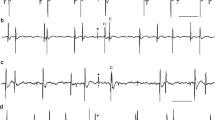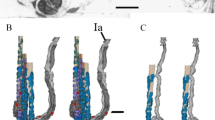Summary
The influence of extrafusal muscle activity in anaemically decerebrate cats upon discharge patterns of primary spindle endings was ascertained by simultaneously recording spike trains from several Ia afferents and muscle tension fluctuations of the triceps-surae muscle.
-
1.
Tension fluctuations were averaged with respect to spikes from primary endings yielding tension “trajectories” of specific shape for each spindle and probably reflecting frequently recurring mechanical events in the spindles' surroundings.
-
2.
Spindles situated in close vicinity and influenced by similar mechanical events as evidenced by similar average tension trajectories are correlated in their discharge patterns to a degree depending on the strength of their mechanical coupling.
-
3.
The modulation of spindle discharge frequency in response to average tension changes at the muscle tendon is very different in amplitude for different spindles; this response may show a high sensitivity. It is usually phase advanced by 90–180° with respect to the “internal length” changes; between spindles there may be phase differences of up to 180°.
-
4.
It is concluded that primary endings react very sensitively to local extrafusal events. The CNS receives much more accurate information about these events in the correlation of several Ia afferents than in the discharge of a single fibre.
Similar content being viewed by others
References
Bawa, P., Mannard, A., Stein, R. B.: Predictions and experimental tests of a visco-elastic muscle model using elastic and inertial loads. Biol. Cybern.22, 139–145 (1976)
Brooks, V. B., Wilson, V. J.: Localization of stretch reflexes by recurrent inhibition. Science127, 472–473 (1958)
Brooks, V. B., Wilson, V. J.: Recurrent inhibition in the cat's spinal cord. J. Physiol. (Lond.)146, 380–391 (1959)
Brown, M. C., Engberg, I., Matthews, P. B. C.: The relative sensitivity to vibration of muscle receptors of the cat. J. Physiol. (Lond.)192, 773–800 (1967)
Burke, D., Hagbarth, K.-E., Löfstedt, L., Wallin, B. G.: The responses of human muscle spindle endings to vibration of non-contracting muscles. J. Physiol. (Lond.)261, 673–693 (1976a)
Burke, D., Hagbarth, K.-E., Löfstedt, L., Wallin, B. G.: The responses of human muscle spindle endings to vibration during isometric contraction. J. Physiol. (Lond.)261, 695–711 (1976b)
Coggshall, J. C., Bekey, G. A.: A stochastic model of skeletal muscle based on motor unit properties. Math. Biosci.7, 405–419 (1970)
Cohen, L. A.: Localization of stretch reflex. J. Neurophysiol.16, 272–285 (1953)
Cohen, L. A.: Organization of stretch reflex into two types of direct spinal arcs. J. Neurophysiol.17, 443–453 (1954)
Goodwin, G. M., Hulliger, M., Matthews, P. B. C.: The effects of fusimotor stimulation during small amplitude stretching on the frequency-response of the primary ending of the mammalian muscle spindle. J. Physiol. (Lond.)253, 175–206 (1975)
Granit, R., Skoglund, S., Thesleff, S.: Activation of muscle spindles by succinylcholine and decamethonium. The effect of curare. Acta Physiol. Scand.28, 134–151 (1953)
Houk, J. C., Singer, J. J., Goldman, M. R.: An evaluation of length and force feedback to soleus muscles of decerebrate cats. J. Neurophysiol.33, 784–811 (1970)
Hunt, C. C.: Relation of function to diameter in afferent fibres of muscle nerves. J. Gen. Physiol.38, 117–131 (1954)
Hunt, C. C., Kuffler, S. W.: Stretch receptor discharges during muscle contraction. J. Physiol. (Lond.)133, 298–315 (1951)
Inbar, G. F., Adam, D.: Estimation of muscle active state. Biol. Cybern.23, 61–72 (1976)
Jewell, B. R., Wilkie, D. R.: An analysis of the mechanical components in frog's striated muscle. J. Physiol. (Lond.)143, 515–540 (1958)
Joyce, G. C., Rack, P. M. H.: Isotonic lengthening and shortening movements of cat soleus muscle. J. Physiol. (Lond.)204, 475–491 (1969)
Joyce, G. C., Rack, P. M. H., Westbury, D. R.: The mechanical properties of cat soleus muscle during controlled lengthening and shortening movements. J. Physiol. (Lond.)204, 461–474 (1969)
Liddell, E. G. T., Sherrington, C. S.: Reflexes in response to stretch (Myotatic reflexes). Proc. Roy. Soc.B96, 212–242 (1924)
Lippold, O. C. J., Redfearn, J. W. T., Vučo, J.: The influence of afferent and descending pathways on the rhythmical and arrhythmical components of muscular activity in man and the anaesthetized cat. J. Physiol. (Lond.)146, 1–9 (1959)
Matthews, B. H. C.: Nerve endings in mammalian muscle. J. Physiol. (Lond.)78, 1–53 (1933)
Matthews, P. B. C., Stein, R. B.: The sensitivity of muscle spindle afferents to small sinusoidal changes of length. J. Physiol. (Lond.)200, 723–743 (1969a)
Matthews, P. B. C., Stein, R. B.: The regularity of primary and secondary muscle spindle afferent discharges. J. Physiol. (Lond.)202, 59–82 (1969b)
Mendell, L. M., Henneman, E.: Terminals of single Ia fibers: Location, density and distribution within a pool of 300 homonymous motoneurons. J. Neurophysiol.34, 171–187 (1971)
Meyer-Lohmann, J., Riebold, W., Robrecht, D.: Mechanical influence of extrafusal muscle on the static behaviour of deefferented primary muscle spindle endings in cat. Pflügers Arch.352, 267–278 (1974)
Milgram, P., Inbar, G. F.: Distortion suppression in neuromuscular information transmission due to interchannel dispersion in muscle spindle firing thresholds. IEEE. Trans. Biomed. Eng. BME23, 1–15 (1976)
Milner-Brown, H. S., Stein, R. B., Yemm, R.: The contractile properties of human motor units during voluntary isometric contractions. J. Physiol. (Lond.)228, 285–306 (1973)
Pollock, L. J., Davis, L.: The reflex activities of a decerebrate animal. J. Comp. Neurol.50, 377–411 (1930)
Poppele, R. E., Bowman, R. J.: Quantitative description of linear behavior of mammalian muscle spindles. J. Neurophysiol.33, 59–72 (1970)
Scott, J. G., Mendell, L. M.: Individual EPSPs produced by single triceps surae Ia afferent fibers in homonymous and heteronymous motoneurons. J. Neurophysiol.39, 679–692 (1976)
Stein, R. B., Bawa, P.: Reflex responses of human soleus muscle to small perturbations. J. Neurophysiol.39, 1105–1116 (1976)
Stein, R. B., Oğuztöreli, M. N.: Does the velocity sensitivity of muscle spindles stabilize the stretch reflex? Biol. Cybern.23, 219–228 (1976)
Watt, D. G. D., Stauffer, E. K., Taylor, A., Reinking, R. M., Stuart, D. G.: Analysis of muscle receptor connections by spike-triggered averaging. 1. Spindle primary and tendon organ afferents. J. Neurophysiol.39, 1375–1392 (1976)
Windhorst, U.: Correlations between discharge patterns of primary spindle endings in active triceps-surae muscles of cats. Pflügers Arch.368, R34 (1977a)
Windhorst, U.: A simple method of cross-correlating spike trains demonstrated on primary muscle spindle ending discharges. Neurosci. Letters5, 57–61 (1977b)
Windhorst, U.: Cross-correlations between discharge patterns of primary muscle spindle endings in active triceps-surae muscles of the cat. Neurosci. Letters5, 63–67 (1977c)
Wolter, S., Windhorst, U.: Muscle tension trajectories in conjunction with discharges of primary endings in active triceps-surae muscles of cats. Pflügers Arch.368, R34 (1977)
Author information
Authors and Affiliations
Rights and permissions
About this article
Cite this article
Windhorst, U., Meyer-Lohmann, J. The influence of extrafusal muscle activity on discharge patterns of primary muscle spindle endings. Pflugers Arch. 372, 131–138 (1977). https://doi.org/10.1007/BF00585326
Received:
Issue Date:
DOI: https://doi.org/10.1007/BF00585326




